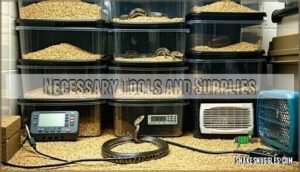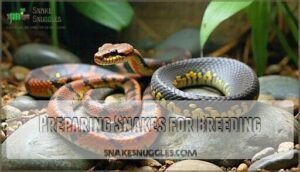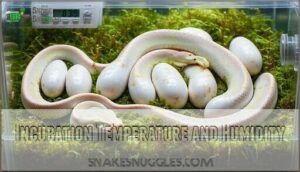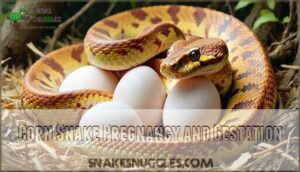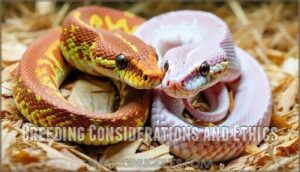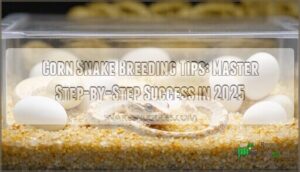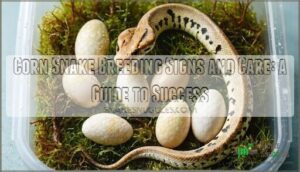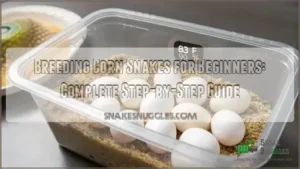This site is supported by our readers. We may earn a commission, at no cost to you, if you purchase through links.
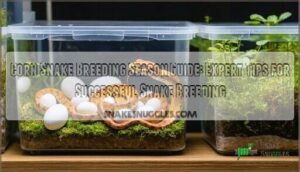
To breed corn snakes, you’ll need to cool them during winter, then warm them up in late February or early March.
Introduce the male to the female, and wait 4-6 weeks for her to lay eggs.
A successful corn snake breeding season guide involves careful planning, attention to temperature, humidity, and nutrition.
By following these steps and considering factors like genetic diversity and snake health, you’ll be well on your way to a successful breeding season, and there’s more to learn about incubation and egg care.
Table Of Contents
- Key Takeaways
- Corn Snake Breeding Basics
- Equipment and Environment
- Preparing Snakes for Breeding
- Selecting Breeding Snakes
- Mating and Fertilization
- Incubation and Egg Care
- Breeding Without Brumation
- Corn Snake Pregnancy and Gestation
- Caring for Newborn Snakes
- Breeding Considerations and Ethics
- Frequently Asked Questions (FAQs)
- What month do corn snakes breed?
- What month is breeding season for snakes?
- Do corn snakes stop eating during breeding season?
- How long do corn snakes live in captivity?
- Can corn snakes be bred in small spaces?
- What colors can corn snakes be bred in?
- How often should I handle breeding snakes?
- Can I breed corn snakes with other species?
- Conclusion
Key Takeaways
- You’ll need to cool your corn snakes during winter and then warm them up in late February or early March to trigger their breeding cycle, so plan carefully to ensure a successful breeding season.
- To create the right environment for breeding, you’ll need to manage temperature, humidity, and nutrition, as these factors can impact the health and fertility of your snakes, and ultimately the success of your breeding program.
- When introducing the male and female snakes, you’ll want to supervise their interaction closely, watching for mating cues like increased activity or pheromone-driven behaviors, and separate them if you notice any signs of stress or aggression.
- After your female snake lays eggs, you’ll need to incubate them at a steady temperature and humidity, monitoring their development closely to ensure healthy hatchlings, and be prepared to provide a suitable environment for your newborn snakes, including a warm, humid space with proper ventilation.
Corn Snake Breeding Basics
When you start breeding corn snakes, you’ll need to understand their seasonal cycles, temperature needs, and humidity requirements.
Breeding corn snakes requires understanding their seasonal cycles and environmental needs.
By managing these factors carefully, you can create the right environment for successful reproduction.
Breeding Season Timing
You’ll notice the corn snake breeding season kicks off in spring, usually March or April.
Seasonal triggers like longer daylight hours and rising temperatures signal the start of the breeding cycle.
Brumation length—typically 8 to 12 weeks—matters, as does the warming period that follows.
Photoperiod impact is key, helping synchronize mating readiness for a successful spring breeding.
Ideal Temperature Range
As you set up for corn snake breeding season, keep temperature in mind at every stage.
Brumation temperatures should stay between 50-60°F to trigger breeding readiness.
For mating and egg development, aim for 75-85°F.
Incubation temperatures matter too—80-85°F helps control hatchling sex.
Regular temperature monitoring and thermostat calibration are key for breeding corn snakes safely and successfully.
Humidity Levels
After dialing in the right temperature, focus on humidity levels.
Aim for 50-60% for routine corn snake breeding, bumping up to 75-80% during egg incubation.
Humidity Monitoring helps prevent respiratory health problems, supports proper shedding success, and keeps eggs from drying out.
Balanced corn snake humidity also stops mold, ensuring strong egg development and smooth snake breeding humidity throughout the season, which is crucial for proper shedding success.
Equipment and Environment
You’ll need the right equipment and a carefully controlled environment to support healthy corn snake breeding.
Precise temperature, humidity, and lighting setups help create the ideal conditions for each stage of the breeding process, which involves a carefully controlled environment.
Necessary Tools and Supplies
Once you’ve got the basics down, it’s time to gather the right gear. Successful breeding means thinking like a scientist—precision matters.
You’ll need:
- Nesting Boxes for egg-laying privacy
- Incubation Medium (like vermiculite) for steady moisture
- Humidity Control tools, such as a hygrometer
- Temperature Regulation devices (thermostats, heat pads)
For proper temperature control, consider using specialized reptile heaters.
- Monitoring Equipment for ongoing checks
Incubator and Heating Options
In the context of incubators, you’ve got options: DIY Incubators or Commercial Incubators.
Both need precise temperature control for stable incubation temperature.
Reliable backup power keeps things steady during outages.
Temperature stability is key; even small fluctuations can harm eggs.
Many breeders source incubator supplies online for convenience.
Here’s a quick comparison:
| Option | Temperature Stability | Backup Power |
|---|---|---|
| DIY Incubators | Varies | Optional |
| Commercial Incubators | High | Often Built-In |
| Glass Tank + Heat Pad | Moderate | Separate Unit |
Humidity Control Methods
After sorting your incubator setup, focus on humidity control. Choose a substrate like sphagnum moss or vermiculite for steady humidity levels during incubation.
Use misting techniques to keep the substrate damp, not soggy. A calibrated hygrometer helps you track changes.
Maintaining proper humidity is easier with a corn snake hygrometer. Good enclosure design and smart ventilation strategies guarantee air flow, preventing mold while keeping the right environment for healthy egg development, which requires careful ventilation strategies.
Preparing Snakes for Breeding
To prepare your corn snakes for breeding, you’ll need to focus on their health, maturity, and proper seasonal conditioning.
Prepare your corn snakes for breeding by focusing on health, maturity, and seasonal conditioning.
Careful attention to brumation, nutrition, and environmental cues guarantees both snakes are ready for a successful breeding season.
Health and Maturity Requirements
Before breeding, make sure your corn snakes meet strict health and maturity benchmarks.
Healthy, breedersized corn snakes should be at least two years old, weigh over two pounds, and reach five feet long.
Don’t skip these four steps:
- Confirm breeding age and weight minimums.
- Book veterinary exams.
- Conduct genetic screening.
- Follow ethical considerations for snake health.
Brumation Process and Benefits
Once your snakes are healthy and mature, it’s time to think about corn snake brumation.
Lower the Brumation Temperature to 50–60°F for a Brumation Length of 8–12 weeks. Don’t feed during this cool period, but always provide water availability.
This hibernation syncs breeding cycles, boosts fertility, and can extend lifespan.
It’s worth pointing out that snake’s age matters when considering brumation.
After brumation, gradually return to normal temperatures.
Feeding and Nutrition Guidelines
After brumation, your corn snake diet needs a boost.
Post-brumation feeding means offering small, frequent meals, helping snakes regain strength.
For gravid females, increase food size and frequency—think nutritious diet, not junk food.
Hatchling first meal should be a pinky mouse, while adults benefit from occasional nutritional supplements.
Watch feeding behavior closely, and avoid obesity by monitoring portions in the snake diet.
Selecting Breeding Snakes
When you’re selecting corn snakes for breeding, focus on their genetics, temperament, and physical maturity to guarantee healthy offspring.
It’s important to choose unrelated, well-nourished snakes with calm behavior and proven lineage for the best breeding results.
Genetic Diversity and Lineage
Once you’ve confirmed your snakes are healthy and mature, focus on genetic diversity. Inbreeding avoidance protects against inherited health issues, while lineage tracking helps you select for desirable corn snake morphs.
Ethical breeding means using corn snake genetics wisely—Trait Selection, Hybrid Vigor, and careful crossbreeding keep your clutches healthy. Documenting family trees guarantees strong, vibrant offspring and responsible breeding practices.
Early breeders faced challenges, but now we’ve access to genetic tracking databases to help maintain pure bloodlines.
Temperament and Behavior Considerations
You’ll often notice snake temperament plays a big role in breeding behavior.
Docile traits reduce breeding stress and make handling easier, while aggression signs or territorial behavior can cause issues.
Always observe snake behavior before pairing—handling impact matters, too.
Favor calm snakes with steady mating behavior, as behavioral genetics can influence offspring.
Prioritize gentle, predictable snakes to guarantee smooth breeding.
Understanding a snake’s temperament is key, so research snake breeds before selecting breeding pairs.
Age and Size Requirements
In regards to corn snake breeding, don’t rush the process—patience pays off.
The minimum age for breeding corn snakes is 2–3 years, with a minimum weight of about two pounds and a length of five feet.
Watch for maturity signs like regular shedding and vigorous health.
Meeting these breeding requirements helps guarantee strong genetics and healthy offspring.
Mating and Fertilization
During the mating process, you’ll introduce the male and female corn snakes in carefully controlled conditions, allowing pheromones and temperature cues to guide their behavior.
Fertilization occurs internally after successful copulation, leading to egg development within the female over the following weeks.
Introducing Male and Female Snakes
After selecting your breeding pairs, the initial introduction is key. Place the male in the female’s enclosure and supervise interaction closely.
Watch for mating cues like increased activity or pheromone-driven behaviors. If you spot aggression, remove them right away. Remember, corn snake breeding is about safety and observation, not rushing the process.
- Watch for gentle nudges or tongue flicks
- Never leave snakes unsupervised
- Separate after any signs of stress
Reorganizing the structure for better readability is essential for understanding the process of corn snake breeding.
Mating Process and Duration
Once you see Pheromone Signals from the female, the snake mating process begins.
The male uses Cloacal Alignment for Sperm Transfer.
Mating behavior is subtle, with snakes intertwining for up to 20 minutes.
This Intertwining Duration is key for Mating Success in reptile mating.
Watch quietly—disturbances can interrupt the mating process.
| Step | Action |
|---|---|
| Pheromone Signals | Female attracts male |
| Cloacal Alignment | Male positions cloaca |
| Sperm Transfer | Mating occurs |
| Intertwining Duration | 10–20 minutes |
Fertilization and Egg Development
A successful corn snake breeding season hinges on precise fertilization and egg development.
- Sperm transfer triggers egg formation inside the female’s body.
- Shell development protects growing embryos, guaranteeing egg viability.
- Fertility factors like temperature and nutrition influence embryo growth, reproductive cycles, and healthy egg laying.
Proper incubation guarantees strong, viable corn snake eggs, which is crucial for a healthy and successful breeding season, relying on key factors such as egg development.
Incubation and Egg Care
You’ll need to keep corn snake eggs at a steady temperature and humidity to guarantee healthy development.
Careful monitoring during incubation helps you spot issues early and gives hatchlings the best chance of survival.
Incubation Temperature and Humidity
After mating, your focus shifts to creating the right environment for incubating snake eggs.
Keep incubation temperature steady at 80-84°F, as temperature fluctuation can affect hatch rate and even sex determination.
Maintain humidity levels between 75-80% using incubation mediums like vermiculite or sphagnum moss.
Optimal humidity is essential for ball pythons too.
Humidity monitoring is key—corn snake eggs need consistent moisture for healthy development during incubation, ensuring the right conditions for successful hatching.
Egg Monitoring and Maintenance
Keeping a close eye on corn snake eggs during incubation is key.
To guarantee healthy development, follow these steps:
- Use Egg Candling weekly to check embryo growth and spot Hatching Issues.
- Monitor Humidity Levels and incubation temperature to avoid Temperature Fluctuations.
- Practice Mold Prevention by ventilating containers and removing condensation.
Regular checks keep incubating snake eggs safe.
Identifying and Addressing Egg Issues
You’ll identify issues with corn snake eggs through egg candling, checking for mold, and monitoring for denting.
Infertile eggs, mold, and dented eggs can lead to hatchling mortality or birth defects, so prompt action is necessary for successful snake incubation and preventing issues like mold prevention.
Breeding Without Brumation
You can breed corn snakes without brumation, but you’ll need to pay close attention to their health and readiness.
This method skips the traditional cooling period, so understanding the risks and proper management is essential for success.
Alternative Methods and Considerations
When exploring corn snake breeding without brumation, you’ll find several alternative methods worth considering.
These approaches can help you adapt to different situations during the snake breeding season:
- Natural Incubation—using ambient room temperatures.
- Communal Breeding—housing multiple females together.
- Asexual Reproduction—rare, but possible in corn snakes.
- Hybridization Risks—mixing species introduces genetic and ethical concerns.
Corn snakes often respond well to photoperiod manipulation techniques to initiate breeding.
Risks and Challenges of Non-Brumation Breeding
During corn snake breeding season, skipping brumation can lead to Reduced Fertility, Higher Mortality, and even Genetic Weakness.
Unproven males may not breed, females might be less receptive, and hatchlings could face long-term health issues.
Ethical Concerns grow if you ignore these snake breeding challenges.
Here’s a snapshot:
| Challenge | Risk Level | Impact |
|---|---|---|
| Reduced Fertility | High | Fewer eggs |
| Higher Mortality | Moderate | Weak hatchlings |
| Genetic Weakness | High | Poor offspring |
Corn Snake Pregnancy and Gestation
Once your corn snake has successfully mated, you’ll notice pregnancy signs within a few weeks as her body prepares for egg development.
Understanding the typical gestation period, physical changes, and care needs helps you support a healthy and stress-free pregnancy.
Duration of Pregnancy and Gestation
After a successful snake breeding season, your female’s gestation length lasts about 30 to 60 days.
During this time, egg development happens inside her, and clutch size can range from 10 to 30 eggs.
Laying frequency is once per season.
Once she lays, incubation timing begins, marking the start of the incubation period for your corn snake breeding project.
Signs and Symptoms of Pregnancy
You’ll notice weight gain, appetite changes, and altered shedding patterns in gravid females.
Abdominal swelling and nesting behavior are also signs.
A prenatal shed often precedes egg laying, indicating ovulation signs, as females prepare to lay a clutch of eggs, signaling pregnancy in corn snakes.
Gravid snakes may also exhibit increased basking behavior to regulate temperature.
Caring for Pregnant Female Snakes
As you care for pregnant female snakes, provide a nesting box.
Increase gravid feeding, including calcium supplementation to prevent shedding issues.
Ensuring a healthy prenatal shed and successful post-laying care for the clutch of eggs prior to egg incubation, is crucial for a healthy outcome.
Caring for Newborn Snakes
You’ll need to provide a suitable environment for your newborn snakes, including a warm, humid space with proper ventilation.
As you care for your newborn snakes, to guarantee their health, monitor their heat, humidity, and ventilation requirements to make certain they thrive and develop into healthy adults.
Housing and Environment Requirements
After eggs hatch, you’ll need to set up a proper home.
Your baby snakes require secure housing.
Here’s what you need:
- Enclosure Size: Start with a small enclosure.
- Substrate Types: Use paper towels or aspen shavings.
- Hiding Spots: Provide several hiding spots.
Remember, these little ones need a safe, stress-free start.
A proper corn snake enclosure is essential for their well-being.
Heat, Humidity, and Ventilation Considerations
You manage temperature gradients and humidity monitoring for newborn snakes.
| Temperature | Humidity |
|---|---|
| 75-85°F | 50-60% |
| 80-90°F | 60-70% |
| 70-80°F | 40-50% |
Ensure airflow importance and avoiding extremes with equipment calibration.
Breeding Considerations and Ethics
You’re about to learn the essential considerations for breeding corn snakes, including responsible practices and ethics.
As you breed your corn snakes, you’ll need to prioritize animal welfare, genetic health, and conservation to guarantee a successful and sustainable breeding program.
Responsible Breeding Practices
After caring for the newborns, consider responsible breeding. It starts with breeder education.
Understand corn snake genetics and ethical considerations. Genetic screening helps in inbreeding prevention. Be aware of hybridization risks.
Maintaining genetic diversity is essential. Address overpopulation issues, and focus on ethical breeding. Remember, responsible breeding protects animal welfare.
Animal Welfare and Conservation
You prioritize animal welfare and conservation by practicing ethical breeding, ensuring genetic diversity, and promoting responsible ownership, which supports conservation efforts and habitat preservation, ultimately enhancing snake welfare.
- Prevent inbreeding
- Preserve habitats
- Support conservation
Genetic Health and Diversity Priorities
When breeding corn snakes, you focus on genetic health and diversity priorities.
| Inbreeding Avoidance | Trait Selection | Lineage Tracking |
|---|---|---|
| Prevents defects | Selects vibrant colors | Maintains hybrid vigor |
Ensures ethical breeding, avoiding inbreeding for healthy snakes.
Frequently Asked Questions (FAQs)
What month do corn snakes breed?
You’ll find corn snakes breed in spring, typically around March or April, when temperatures and daylight hours increase, triggering their hormonal cycles and signaling the start of breeding season naturally.
What month is breeding season for snakes?
You’ll discover snakes typically breed in spring, around March or April, as increasing temperatures and daylight trigger their hormonal cycles, signaling the start of their breeding season naturally.
Do corn snakes stop eating during breeding season?
You won’t see corn snakes completely stop eating during breeding season, but their appetite may decrease as they focus on mating and reproduction.
With feeding reduced or stopped in some cases, this change in behavior is notable, particularly as it relates to breeding season.
How long do corn snakes live in captivity?
You’ll be surprised, but corn snakes can live up to 20-25 years in captivity, given proper care, nutrition, and a safe environment, which is quite impressive for a snake.
Can corn snakes be bred in small spaces?
You can breed corn snakes in small spaces, but make certain proper ventilation, temperature control, and humidity to mimic their natural environment and support healthy reproduction.
What colors can corn snakes be bred in?
You can breed corn snakes in various colors, including albino, snow, lavender, and blood red, by selecting snakes with desirable traits and understanding corn snake genetics.
How often should I handle breeding snakes?
You should handle breeding snakes minimally, ideally once a week, to reduce stress and prevent disrupting their natural behavior, ensuring a healthy and successful breeding process for your corn snakes.
Can I breed corn snakes with other species?
You shouldn’t breed corn snakes with other species, as it can lead to genetic issues, birth defects, and unhealthy offspring, compromising the snakes’ well-being and genetic diversity.
Conclusion
As you begin the journey of corn snake breeding, the key to success lies in mastering the corn snake breeding season guide.
By following expert tips, you’ll navigate the process with ease, ensuring a thriving breeding season.
A successful corn snake breeding season guide will be your roadmap to raising healthy snakes.
- https://www.herps-and-inverts.com/how-to-breed-corn-snakes/
- http://www.uvma.org/snakes/corn-snakes/breeding-corn-snakes.htm
- https://reptilesmagazine.com/how-to-breed-the-popular-corn-snake/
- https://carpenternaturecenter.org/wp-content/uploads/2019/06/Corn-Snake-Natural-History.pdf
- https://www.youtube.com/watch?v=aJOzTaJLUGA

